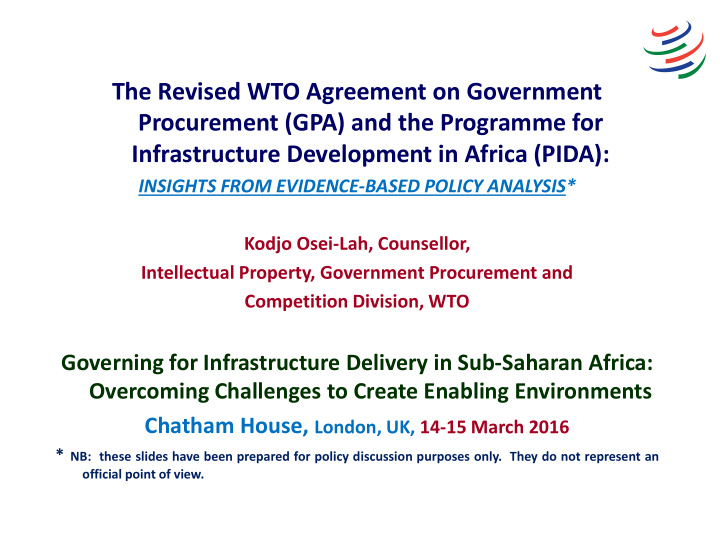



The Revised WTO Agreement on Government Procurement (GPA) and the Programme for Infrastructure Development in Africa (PIDA): INSIGHTS FROM EVIDENCE-BASED POLICY ANALYSIS* Kodjo Osei-Lah, Counsellor, Intellectual Property, Government Procurement and Competition Division, WTO Governing for Infrastructure Delivery in Sub-Saharan Africa: Overcoming Challenges to Create Enabling Environments Chatham House, London, UK, 14-15 March 2016 * NB: these slides have been prepared for policy discussion purposes only. They do not represent an official point of view.
Key issues o Is the GPA relevant to Africa's infrastructure development, trade and development prospects? o What are the potential synergies with PIDA, and the potential benefits and challenges of accession to the Agreement? o Reflection 2
A1. Africa infrastructure: challenge and opportunity o Africa’s infrastructure deficit – barrier to region’s development o Solution includes PIDA, with complementary national elements – Overall goal: “ promote socio-economic development and poverty reduction in Africa through improved access to integrated regional and continental infrastructure and services ” (source: NEPAD) • 30-year programme: 2010-2040 ; Cost: $360 billion • Focus: Energy, Transport, ICT, Trans-Boundary Water o Successful delivery of PIDA: foster growth & prosperity – Deliver extra 2% GDP growth to 6.25% pa – Six-fold plus rise in GDP from $3.3 to $20.3 trillion in one generation – Doubling of Africa’s share of its regional trade and of world trade – Creation of some 15 million jobs o Challenges to successful PIDA implementation include : – Significant financing gap – up to half of annual financing need – Absence of uniform governance framework 3
A2. PIDA Implementation: is there a role for the GPA? o GPA – should African countries join? Potential benefits – Governance instrument: international ‘stamp of approval’, foster value for money, efficient resource utilisation, inward investment – Trade instrument: $1.7 trillion GPA covered procurement market • Help liberalise African regional procurement markets – Transitional measures: use to limit the entry costs of accession, foster development of productive capacity, strategic sectors, etc. – International policy landscape: synergies, complementarities o GPA – should African countries join? Potential challenges – Preparatory, negotiating and implementation costs – Adjustment costs for local industry – ‘Policy space ’ considerations – other policy issues – e.g. Africa’s own regional integration agenda o But note: sunk costs, paid price, opportunity costs – Previous/ongoing reforms, opportunity costs of non-participation 4
A3. Synergies with national and international disciplines: the GPA as a minimum standard Synergies Shared Core Principles • Transparency • Non-discrimination UNCITRAL Model Law • Procedural equity • Competition • Objectivity • Integrity/Anti-corruption • Accountability IFIs, e.g. GPA WB • Value for money 5
B1. The GPA & PIDA: trade dimension in numbers Size of African regional govt proc market @ 15% GDP 2040 2010 3050 Total overall Africa 15% 495 region government 15% procurement market size under PIDA growth scenario, @ 15%/20% GDP ($ billion) (2005 $ PPP) Rest of the Economy 2805 17284 85% 85% Total GDP: $3'300 billion Total GDP: $20'334 billion 6
B2. The GPA and PIDA: trade dimension in numbers (2) o The trade dimension of PIDA: African regional dimension – potential size of African regional govt proc market (15-20% of GDP): $495-660 bn at start (2010), rising to $3.05-4.07 trn at end (2040) o Liberalisation of African regional govt proc market to GPA standards (2.5-6.4% of GDP*) – $82.5 - $211.2 bn at start, rising to $508bn - $1.3 trn at end o Notional African countries’ share of own regional procurement market** – $11.5 - $29 bn at start to $141.3 - $361.8 bn at end o Notional African share GPA covered procurement market** – $59.5 bn at start to $149.8-197.9 bn at end *Anderson et al (2012); **See Niggli and Osei-Lah (2014) 7
B3. The GPA & PIDA: trade dimension in numbers (3) *Shown: market size @ 2.5% GDP 8
C. Reflection: policy considerations o The GPA and PIDA: positive net cost/benefit position o Task: leveraging synergies to deliver enhanced infrastructure, trade and development outcomes o Challenge: overcoming constraints, translating the potential benefits into on-the-ground realities o Takeaway: the GPA: does it merit a closer look by African countries in the context of PIDA? ________________ 9
For further information/reflection: o Anderson, Robert D. (2010). "The WTO Agreement on Government Procurement (GPA): An Emerging Tool of Global Integration and Good Governance," Law in Transition , Autumn 2010, pp. 1-8 to 8-8; available at: http://www.ebrd.com/downloads/research/news/lit102.pdf. o Anderson, Robert D., Philippe Pelletier, Kodjo Osei-Lah and Anna Caroline Müller, Assessing the Value of Future Accessions to the WTO Agreement on Government Procurement (GPA): Some New Data Sources, Provisional Estimates, and An Evaluative Framework for Individual WTO Members Considering Accession (WTO Working Paper ERSD-2011-15, October 2011), available at http://www.wto.org/english/res_e/reser_e/ersd201115_e.htm. o Niggli, Nicholas and Kodjo Osei- Lah (2014). “Infrastructure Provision and Africa’s Trade and Development Prospects: Potential Role and Relevance of the WTO Agreement on Government Procurement (GPA)," WTO Working Paper ERSD-2014- 20 , November 2014; available at: https://www.wto.org/english/res_e/reser_e/ersd201420_e.pdf 10
Recommend
More recommend